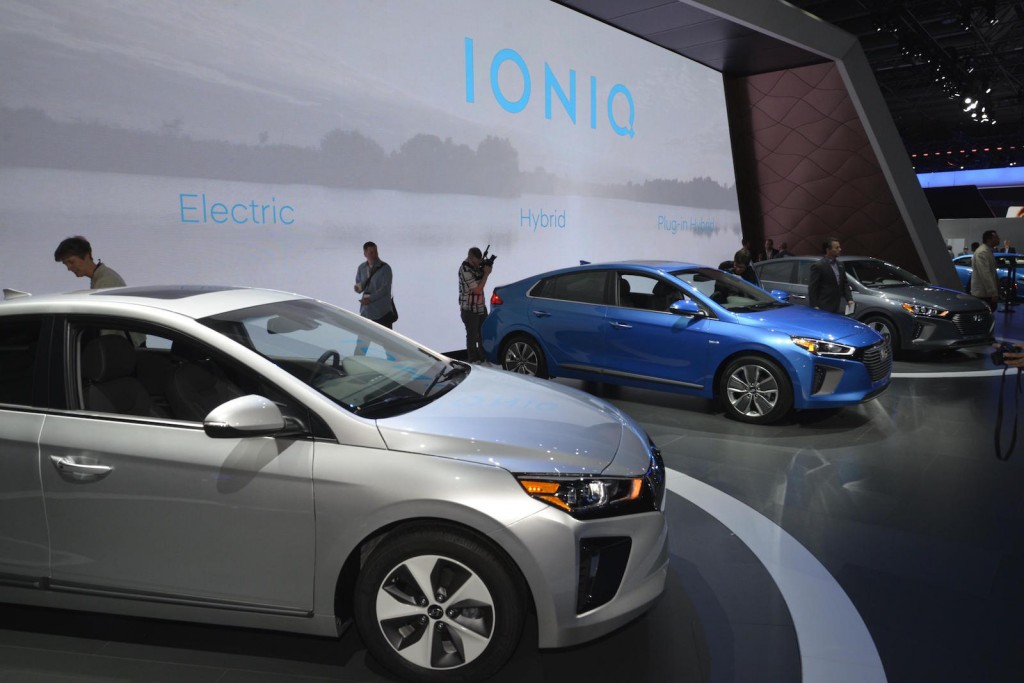The 2017 Hyundai Ioniq lineup of hybrid, electric, and plug-in hybrid hatchbacks won't hit the market until late this year, but Hyundai product executives are eager to talk about the cars.
At a roundtable during last week's New York Auto Show, product planning vice president Mike O'Brien and manager John Shon sat down with journalists to answer questions on the new dedicated green model.
Among their themes: this is a car that's "normal" and fun to drive, not a "futuristic" vehicle, like the new fourth-generation Toyota Prius—and it will be a core volume model for Hyundai.
WATCH THIS: 2017 Hyundai Ioniq preview video
That approach should give "fence sitters," who want the best fuel economy but don't want an unusual-looking vehicle, a new and attractive option, according to Shon.
Of the three versions, Hyundai expects that the Ioniq Hybrid will be the most popular by far, though all three will be available in all 50 states.
After that, Hyundai suggests that the Ioniq Electric—with a range projected at about 110 miles—will likely be more popular than the Ioniq Plug-In, at least initially, due to the larger Federal income-tax credit available.

2017 Hyundai Ioniq, 2016 New York Auto Show
While the electric and plug-in hybrid models won't necessarily be represented on all dealer lots, unlike the hybrid, they can be ordered for customers by dealers in any state.
The hybrid Ioniq will have, O'Brien said, the highest EPA combined fuel-economy rating of any car without a plug sold in the U.S.
That means higher than the 56-mpg combined rating of the 2016 Toyota Prius Eco version, although the Prius is a somewhat larger vehicle than the Ioniq.
ALSO SEE: How GM plans to market Chevy Volt plug-in hybrid, Bolt EV electric car
The U.S. power rating of the Ioniq Hybrid will be 139 horsepower, with the electric motor rated at 32 kilowatts (43 hp) and the direct-injected 1.6-liter gasoline engine at 104 hp.
Asked about the customers for the two Ioniqs with plugs, O'Brien and Shon both echoed themes we'd heard from Darin Gesse, who's reponsible for marketing the Chevrolet Volt and Bolt EV.
That is, customers for any of these cars come in highly informed already, in many cases knowing more than the salespeople they interact with.

2017 Hyundai Ioniq, 2016 New York Auto Show
The company is working aggressively to train all of its dealers on the Ioniq, Shon said, but currently low gasoline prices pose a challenge.
"It's very difficult" to get customers to consider more expensive alternate powertrains at dealers, O'Brien said, based on several years of experience with the Sonata Hybrid.
Together with a new Plug-In Hybrid variant, the pair of hybrid Sonatas combined represents about 10 percent of total Sonata sales.
CHECK OUT: 2016 Hyundai Sonata Hybrid, Plug-In Hybrid First Drive
That's higher than the current percentages for the Toyota Camry and Ford Fusion, O'Brien noted.
But as noted by trade journal Ward's Auto, Hyundai's U.S. CEO Dave Zuchowski acknowledged that the company may have to put incentives on the new Ioniq to get the sales it hopes for.
It's too early to discuss what home-charging solutions Hyundai will offer to buyers of the electric and plug-in hybrid Ioniqs, O'Brien said.

2017 Hyundai Ioniq, 2016 New York Auto Show
One interesting technical aspect of the Ioniq range: the cars have no 12-volt battery. Instead, the engine is started and accessories are run by one module of the high-voltage pack.
Asked to sum up Hyundai's hopes for the Ioniq, O'Brien paused.
"We've just got one shot," he said. "We have to be the best."
_______________________________________













